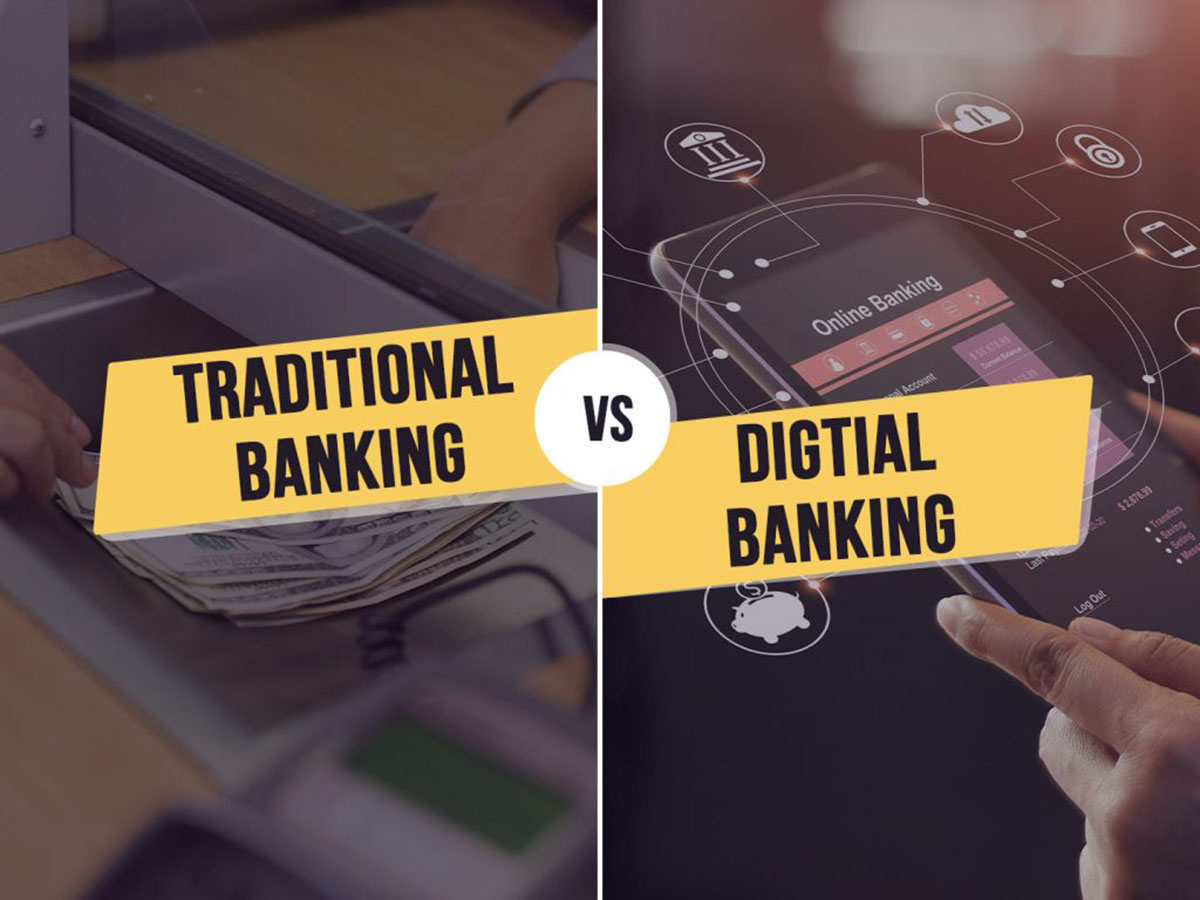Home>Finance>The Differences When Using Electronic Banking Compared To Traditional Methods


Finance
The Differences When Using Electronic Banking Compared To Traditional Methods
Published: October 13, 2023
Discover the advantages of electronic banking over traditional methods in the world of finance. Simplify your financial transactions and enjoy convenience with secure online banking.
(Many of the links in this article redirect to a specific reviewed product. Your purchase of these products through affiliate links helps to generate commission for LiveWell, at no extra cost. Learn more)
Table of Contents
Introduction
Welcome to the digital age, where technology continues to revolutionize every aspect of our lives, including banking. In recent years, electronic banking has gained immense popularity for its convenience and efficiency. Gone are the days of waiting in long queues at the bank or filling out tedious paperwork. With the click of a button, you can now perform a wide variety of financial transactions from the comfort of your own home or anywhere with an internet connection.
Electronic banking, also known as online banking or internet banking, allows individuals to access their bank accounts and conduct financial transactions electronically. This can include activities such as checking account balances, transferring funds between accounts, paying bills, and even applying for loans. The rise of electronic banking has transformed the way we manage our finances and has made traditional brick-and-mortar banking seem outdated in comparison.
While traditional banking methods served us well for many years, electronic banking offers numerous advantages that have made it the preferred choice for millions of people worldwide. In this article, we will explore the various benefits of electronic banking and compare it to traditional banking methods to understand the key differences between the two.
Convenience of Electronic Banking
One of the main advantages of electronic banking is the unparalleled convenience it offers. With online banking, you no longer have to adhere to the limited banking hours or travel to a physical branch. You can access your accounts and manage your finances anytime and anywhere, as long as you have an internet connection and a device such as a computer or smartphone.
Gone are the days of rushing to the bank before it closes or waiting in long lines to deposit a check or withdraw cash. Electronic banking allows you to effortlessly perform various transactions with just a few clicks. Need to transfer funds between accounts? Simply log in to your online banking platform and initiate the transfer. Want to pay your bills? Online banking allows you to set up recurring payments or make one-time payments with ease.
Another convenience offered by electronic banking is the ability to access your financial information in real-time. You can view your account balances, transaction history, and even receive electronic statements instantly. This valuable information is available at your fingertips, providing you with better control and visibility over your finances.
Additionally, electronic banking eliminates the need for physical paperwork. No more filling out forms or signing multiple copies of documents. With online banking, most processes are automated and digital, reducing the time and effort required to complete financial tasks. This not only saves you precious time but also contributes to a more eco-friendly environment by reducing paper waste.
Overall, the convenience provided by electronic banking is unparalleled. It gives you the freedom to manage your finances on your own terms, at any time and from anywhere, making it an ideal choice for individuals with busy schedules or those who prefer the comfort of handling their financial affairs from the convenience of their own homes.
Accessibility of Electronic Banking
Electronic banking offers unparalleled accessibility, allowing individuals to access their finances and conduct transactions with ease. Unlike traditional banking methods that require physical presence at a bank branch, electronic banking provides a wide range of options to access your accounts.
First and foremost, online banking platforms are accessible through a variety of devices, including computers, laptops, tablets, and smartphones. This means you can conveniently manage your finances using the device that best suits your needs and preferences. Whether you’re at home, at work, or on the go, as long as you have an internet connection, you can access your accounts and perform transactions.
Furthermore, electronic banking platforms often offer mobile applications that are specifically designed for smartphones. With these applications, you have instant access to your accounts, right at your fingertips. You can check your account balances, transfer funds, pay bills, and even deposit checks by simply taking a photo on your phone. This level of accessibility ensures that your finances are always within reach, regardless of your location.
In addition to device accessibility, electronic banking also provides the flexibility of banking beyond traditional working hours. With online banking, there is no need to rush to the bank before it closes or wait for the next business day to conduct your financial transactions. Electronic banking platforms are available 24/7, allowing you to manage your accounts at any time that is convenient for you.
Another aspect of accessibility is the ability to access multiple accounts from different financial institutions through a single online banking platform. This eliminates the need to remember multiple login credentials and visit multiple websites or branches to manage your finances. Electronic banking simplifies the process by providing a centralized platform where you can access all your accounts, including checking, savings, credit cards, and investments, all in one place.
Overall, the accessibility of electronic banking allows individuals to manage their finances at their own convenience, using various devices and accessing their accounts anytime, anywhere. This level of flexibility and convenience sets electronic banking apart from traditional banking methods, making it a preferred choice for many.
Security of Electronic Banking
When it comes to electronic banking, security is of utmost importance. Banks and financial institutions have invested heavily in implementing robust security measures to protect customer information and ensure the safety of online transactions.
One of the key security features of electronic banking is encryption. When you access your online banking platform, the information transmitted between your device and the bank’s server is encrypted, making it extremely difficult for unauthorized parties to intercept and decipher the data. This ensures that your personal and financial information remains private and secure.
Furthermore, most online banking platforms employ multi-factor authentication to verify the identity of users. This typically involves a combination of something you know (such as a password or PIN), something you have (such as a unique code sent to your mobile device), and something you are (such as your fingerprint or facial recognition). This layered approach adds an extra layer of security by requiring multiple pieces of information to gain access to your accounts.
Electronic banking platforms also monitor and detect suspicious activities through advanced fraud detection systems. They use algorithms and artificial intelligence to analyze transaction patterns and identify potential fraudulent behavior. If any suspicious activity is detected, the bank may automatically freeze the account or contact the customer to verify the legitimacy of the transaction. This proactive approach helps to prevent unauthorized access and protects customers from financial fraud.
Additionally, banks invest in secure servers and firewalls to protect the integrity of their online banking systems. They continuously update their security protocols to stay ahead of potential threats and vulnerabilities. Regular security audits and penetration tests are conducted to identify and address any potential weaknesses in the system.
It is important for customers to play their part in ensuring the security of their electronic banking transactions. This includes using strong and unique passwords, regularly updating passwords, avoiding accessing online banking on public Wi-Fi networks, and being cautious of phishing attempts and fraudulent emails.
While no system is completely immune to security risks, electronic banking has proven to be secure when proper precautions are taken. Banks and financial institutions are committed to maintaining the confidentiality, integrity, and availability of customer data, making electronic banking a secure and reliable option for managing your finances.
Speed of Transactions with Electronic Banking
One of the significant advantages of electronic banking is the speed at which transactions can be executed. Compared to traditional banking methods, electronic banking offers a much faster and more efficient way to manage your finances.
With electronic banking, transactions that used to take hours or even days to complete can now be processed almost instantly. Whether you need to transfer funds between your own accounts, send money to a friend or family member, or pay your bills, the whole process is streamlined and accelerated.
For example, when transferring funds between your accounts using traditional methods, you would typically need to visit the bank, fill out a paper form, and wait for the transaction to be processed manually. This could take several hours or even days, depending on various factors such as bank processing times and cut-off times for transactions. However, with electronic banking, the same transaction can be initiated and completed within a matter of minutes.
Electronic banking also enables the instant verification and confirmation of transactions. Once you initiate a transaction, you can usually receive an immediate confirmation or notification through email or text message. This real-time confirmation provides peace of mind and ensures that your transaction has been successfully processed.
In addition to the speed of individual transactions, electronic banking also allows for efficient and streamlined financial management. You can set up recurring payments for bills and subscriptions, eliminating the need to manually make monthly payments. This automation saves time and effort, ensuring that your bills are paid on time without any delays or late fees.
The speed of transactions with electronic banking is further enhanced by the integration with other digital platforms. Many electronic banking platforms allow for seamless integration with mobile payment services, such as Apple Pay or Google Pay, allowing you to make contactless payments with just a tap of your smartphone. This eliminates the need to carry cash or physical cards and accelerates the checkout process.
Overall, the speed of transactions with electronic banking provides a significant advantage over traditional banking methods. Whether it’s transferring funds, paying bills, or making mobile payments, electronic banking streamlines the process and allows for instant, efficient, and hassle-free financial transactions.
Cost-Effectiveness of Electronic Banking
Electronic banking not only offers convenience and efficiency, but it can also be a cost-effective option for managing your finances. Compared to traditional banking methods, electronic banking can help save you money in several ways.
First and foremost, electronic banking eliminates the need for physical paperwork and manual processing. With online banking, most transactions and account management tasks can be done digitally, reducing the reliance on paper documents and reducing the associated costs. This includes savings on items such as deposit slips, checkbooks, and statement fees. Some banks even offer incentives, such as waiving certain fees or providing complimentary services for customers who choose electronic banking.
In addition, electronic banking can help you save on transportation costs. With traditional banking, you may need to regularly visit the bank to deposit checks, withdraw cash, or conduct other financial transactions. This often involves travel expenses, parking fees, or even the need to take time off work. Electronic banking eliminates these costs as you can conveniently perform most transactions from the comfort of your own home or office, without the need to travel.
Furthermore, online banking allows you to easily compare the fees and interest rates offered by different financial institutions. This enables you to make informed decisions and choose banking products and services that are most favorable to your financial needs. You can shop around for the best interest rates on savings accounts or find credit cards with lower interest rates or attractive rewards programs. This level of transparency and choice provides you with the opportunity to optimize your financial management and potentially save money in the long run.
Electronic banking also encourages better financial management and budgeting. Many online banking platforms provide tools and features to track and categorize your expenses, analyze your spending patterns, and set financial goals. By having a clearer understanding of your financial habits, you can identify areas where you can cut costs, save more, and make more informed financial decisions.
Overall, electronic banking offers a cost-effective approach to managing your finances. It reduces the need for physical paperwork, eliminates transportation costs, provides transparency on fees and interest rates, and encourages better financial management. By taking advantage of these cost-saving benefits, you can optimize your financial management and potentially save money in the process.
Traditional Methods of Banking
Before the advent of electronic banking, traditional methods of banking were the primary means by which individuals managed their finances. Traditional banking refers to the process of visiting a physical bank branch and conducting transactions with the assistance of bank tellers and customer service representatives.
In traditional banking, customers would typically visit the bank during operating hours to perform a wide range of transactions, such as cash deposits and withdrawals, check encashment, opening and closing accounts, and applying for loans. Customers would interact face-to-face with bank staff and present the necessary identification and documentation to complete the transactions.
Traditional banking also involved the use of physical paperwork. For instance, customers needed to fill out paper forms to request services, open accounts, or apply for loans. These paper-based processes often required documentation, signatures, and multiple copies of paperwork.
In addition, traditional banking relied heavily on manual processes. Transactions such as check processing or transferring funds between accounts had to go through a series of manual verification and approval steps, which could contribute to longer processing times.
Moreover, access to banking services was limited to the bank’s operating hours and physical branch locations. Customers had to plan their visits accordingly, considering factors such as branch proximity and busy periods which could result in long waiting times.
While traditional banking methods served as the standard for many years, they are gradually being replaced by electronic banking due to its numerous advantages and advancements in technology. However, it is worth noting that traditional banking is still preferred by some individuals who appreciate face-to-face interactions, personalized service, and the reassurance of physical bank branches.
Overall, traditional banking methods were the foundation of the banking industry for many years. They relied on physical branch visits, paper-based processes, and manual transactions. However, as technology continues to evolve, electronic banking has emerged as a more convenient and efficient alternative.
Differences Between Electronic Banking and Traditional Methods
Electronic banking and traditional banking methods differ significantly in various aspects, revolutionizing the way individuals manage their finances. Let’s explore the key differences:
- Convenience: Electronic banking offers unparalleled convenience, allowing individuals to access their accounts and perform transactions anytime and anywhere with an internet connection. In contrast, traditional banking requires in-person visits to bank branches during limited operating hours.
- Accessibility: Electronic banking provides access to accounts through various devices, including computers, smartphones, and tablets. Traditional banking access is limited to physical bank branches and ATMs.
- Security: Electronic banking employs advanced encryption, multi-factor authentication, and fraud detection systems to ensure the security of customer information and transactions. Traditional banking methods rely on physical identification documents and manual verification processes.
- Speed: Electronic banking allows for instant transactions, with transfers and payments processed within minutes. Traditional banking transactions often take longer, requiring manual processing, paperwork, and bank business hours to complete.
- Cost-effectiveness: Electronic banking eliminates physical paperwork and reduces transportation costs, making it a cost-effective option. Traditional banking may involve fees for paper statements, checkbooks, and in-person services.
- Financial management tools: Electronic banking platforms provide tools to track expenses, set budgets, and analyze spending patterns. Traditional banking methods require manual tracking and budgeting.
- Personalized service: Traditional banking allows for face-to-face interactions with bank staff, offering a more personal touch and assistance in complex transactions. Electronic banking relies on digital interactions, limiting personalization.
- 24/7 access and automation: Electronic banking operates 24/7, allowing customers to manage their finances at their convenience, while traditional banking is limited to banking hours. Electronic banking also offers automation features for recurring payments and transfers.
- Transaction history and record-keeping: Electronic banking platforms maintain digital transaction history, accessible at any time. Traditional banking relies on paper receipts and statements, requiring physical storage and organization.
These differences highlight the transformational shift brought about by electronic banking. While traditional banking still offers personalized service and face-to-face interactions, electronic banking provides unparalleled convenience, speed, accessibility, and cost-effectiveness. It empowers individuals with greater control over their finances and eliminates many of the limitations and inefficiencies associated with traditional banking methods.
Conclusion
The rise of electronic banking has revolutionized the way individuals manage their finances. The convenience, accessibility, security, speed, and cost-effectiveness offered by electronic banking have made it a preferred choice for many over traditional banking methods.
Electronic banking provides unparalleled convenience, allowing individuals to access their accounts and perform transactions anytime and anywhere. The 24/7 availability, instant transactions, and automation features simplify financial management and save valuable time.
The security measures implemented by electronic banking platforms, such as encryption, multi-factor authentication, and fraud detection systems, ensure the safety of customer information and transactions. These robust security measures provide peace of mind and protect against financial fraud.
Furthermore, electronic banking offers cost-saving benefits by eliminating physical paperwork, reducing transportation costs, and providing access to competitive rates and fees. It promotes financial transparency, allowing individuals to make informed decisions and optimize their financial management.
While traditional banking methods still offer the personalized service and face-to-face interactions that some prefer, electronic banking has undoubtedly transformed the banking landscape. It empowers individuals with greater control over their finances and offers a more efficient and convenient way to manage their money.
In conclusion, electronic banking has redefined the banking experience, providing a seamless and user-friendly platform for individuals to handle their financial needs. Its growing popularity and continuous advancements in technology make it clear that electronic banking is here to stay, shaping the future of the banking industry.














